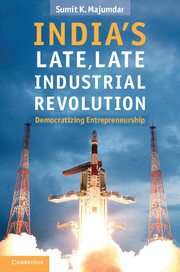Book contents
- Frontmatter
- Contents
- Figures
- Tables
- Acknowledgments
- Preface
- 1 Vent for growth
- 2 Industrial revolutions
- 3 Aspects of Indian enterprise history
- 4 The emergence of modern industry
- 5 Asian late industrialization
- 6 Democratizing entrepreneurship
- 7 Contemporary India
- 8 The services sector debate
- 9 A paean for manufacturing
- 10 Reindustrializing India
- Appendix
- Notes
- Bibliography
- Index
3 - Aspects of Indian enterprise history
Published online by Cambridge University Press: 05 June 2012
- Frontmatter
- Contents
- Figures
- Tables
- Acknowledgments
- Preface
- 1 Vent for growth
- 2 Industrial revolutions
- 3 Aspects of Indian enterprise history
- 4 The emergence of modern industry
- 5 Asian late industrialization
- 6 Democratizing entrepreneurship
- 7 Contemporary India
- 8 The services sector debate
- 9 A paean for manufacturing
- 10 Reindustrializing India
- Appendix
- Notes
- Bibliography
- Index
Summary
Commerce and industry in ancient India
This history of India’s entrepreneurial activity goes back to the dawn of civilization. India has been a commercialized country for over 4,500 years. Unlike in the United States, in which there was no industrialization at all prior to the eighteenth century, India had been an industrialized country thousands of years ago as well. Then there was a hiatus and only in the last 150 years or so has India resumed the path of industrialization. The story of the evolution of Indian enterprise is fascinating, since the time-paths of this particular process reflect the ebbs and flows of generic human civilization in one land mass.
In the 1870s, when Major General Alexander Cunningham, the Archaeological Surveyor to the Government of India, published details of the first Harappan seal, which had been discovered at an ancient site in Harappa in what is now the Pakistan part of Punjab, the world become aware of what might potentially be India’s past. Not until the early 1920s, when archeologists Daya Ram Sahni and Madho Sarup Vats discovered the city of Harappa, and Rakhal Das Banerjee discovered the city of Mohenjo Daro in Sind, both on the banks of the Indus, were the secret of India’s past civilization finally revealed. The then Director General of the Archaeological Survey of India, John Marshall, stated that: “India … must henceforth be recognized … as one of the most important areas where civilizing processes were initiated and developed.”
- Type
- Chapter
- Information
- India's Late, Late Industrial RevolutionDemocratizing Entrepreneurship, pp. 67 - 94Publisher: Cambridge University PressPrint publication year: 2012



